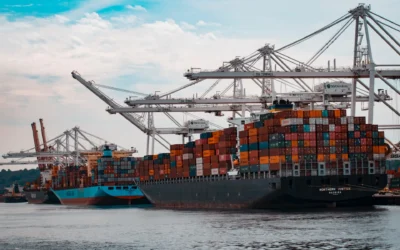Understanding Supply Chain Planning: Essential Components and Emerging Trends
As companies face unprecedented challenges and opportunities, a well-structured supply chain plan not only optimises production processes but also enhances the overall value delivered to customers.
To truly understand what supply chain planning is, we need to understand the fundamentals of supply chain planning, its key components, and emerging trends for 2024 shaping the industry.
What is Supply Chain Planning?
Supply chain planning is comprehensive process that involves the management and optimisation of supply chain activities, from procurement of raw materials to the delivery of finished products.
It aims to balance demand and supply, ensuring that the right products are available at the right time, place, and cost. This intricate balancing act is vital for minimising shortages and surpluses, thereby enhancing operational efficiency and customer satisfaction.
Key Components of Supply Chain Planning
- Demand Forecasting:
Predicting customer demand to ensure that products are produced in the right quantities. - Inventory Management:
Maintaining optimal inventory levels to avoid excess stock or shortages. - Production Planning:
Scheduling production runs to meet forecasted demand while optimising resources. - Logistics and Distribution:
Coordinating the movement of goods from suppliers to customers efficiently. - Supplier Relationship Management:
Managing interactions with suppliers to ensure the timely supply of materials.
Each component plays a critical role in the seamless flow of goods and services, contributing to the overall efficiency of the supply chain management system.
The Importance of Supply Chain Planning
For supply chain leaders, effective supply chain planning is crucial for maintaining a competitive edge in the market. It allows brands and products to respond swiftly to market changes, minimise operational costs, and enhance customer satisfaction.
A robust supply chain plan process enables businesses to manage risks better, streamline processes, and improve the quality of products delivered to customers.
Supply Chain Planning trends for 2024-2025
1. Digital and Data-Driven Supply Chains
Digital supply chains are defined by the integration of advanced technologies like AI, IoT, and blockchain. These technologies convert physical data into digital formats, enabling smarter supply chains and more connected production lines, warehouses, logistic centres, distribution networks, etc. The primary benefits include:
- Enhanced Visibility:
Real-time tracking of goods and inventory across the entire supply chain helps in identifying bottlenecks and inefficiencies. - Optimised Operations:
Automation and data analytics allow for better demand forecasting, inventory management, and logistics planning, as a result, brands can reduce their manufacturing costs, improve production profitability and increase margins. customer service. - Predictive Decision-Making:
With predictive analytics, companies can anticipate issues before they arise, such as equipment failures, supply shortages or demand forecasting, allowing supply chain leaders to make more informed decisions, while taking proactive measures to improve their supply chain planning.
2. Resilience and Agility
Building resilience and agility in supply chains are essential for responding to disruptions like natural disasters, geopolitical tensions, or pandemics. Key aspects include:
- Diversifying Suppliers:
Companies are increasingly sourcing from multiple suppliers to reduce reliance on any single source. - Risk Management:
Developing robust contingency plans, including inventory buffers and alternative transportation routes. - Flexibility:
Implementing technologies and processes that allow quick adaptation to change in demand or supply conditions, such as flexible manufacturing systems. For supply chain leaders, it is important to select manufacturing partners with a global footprint, ensuring flexible and seamless transitions of production across an established supply chain.
3. Sustainability and Green Initiatives
When thinking of supply chain planning, supply chain leaders have a role to play to reduce environmental impact and promoting eco-friendly production practices. Key initiatives include:
- Carbon Footprint Reduction:
Work with suppliers that are working to minimise emissions through optimised transportation, energy-efficient manufacturing processes, the use of renewable energy throughout the supply chain, and strong focus on waste reduction and recyclability of materials. - Regulatory Compliance:
Ensure that your suppliers adhere to environmental regulations and standards, such as reducing hazardous materials in products, also comply with industry standard ISO accreditations or industry body regulators. - Consumer Expectations:
With increasing consumer demand for sustainable products, companies are adopting practices like sustainable sourcing, recycling, and circular economy models.
4. Investment in Technology and Skills
Investing in technology and skills is vital for modern supply chains. This includes:
- Automation:
Implementing robotics, automated systems and data driven decision platforms, help to streamline supply chain processes from manufacturing to the distribution. - Cybersecurity:
Protecting supply chain networks from cyber threats by investing in advanced security measures. - Training and Development:
Providing employees with the necessary skills to manage new technologies and adapt to changing roles, fostering a culture of innovation.
5. Geopolitical Adjustments and Regionalisation
The geopolitical landscape is leading to a shift from global to more regional supply chains. Key elements include:
- Near-shoring and Friend-Shoring:
Moving production closer to key markets or within countries with friendly diplomatic relations to reduce risks associated with long-distance logistics. - Supply Chain Security:
Ensuring that critical components are sourced from reliable and politically stable regions to avoid disruptions. - Regionalisation:
Simplifying supply chain networks by focusing on regional production and distribution, which can result in lower transportation costs, faster delivery times, and increased responsiveness to local market needs.
The Strategic Edge of Modern Supply Chain Planning
Supply chain planning is a vital aspect of modern manufacturing, allowing companies to stay competitive and agile in response to market fluctuations. By thoroughly understanding its core elements and integrating advanced technologies, businesses can significantly boost their efficiency and responsiveness.
Embracing the latest trends and focusing on customer-centric approaches not only streamlines operations but also enhances customer satisfaction. For companies like Intretech, these practices are instrumental in maintaining a robust global presence and delivering high-quality products across diverse industries.
Explore more related content
How Malaysia Became Southeast Asia’s Leading Manufacturing Hub
How Malaysia Became Southeast Asia's Leading Manufacturing HubAs manufacturing has become increasingly globalised,...
Supply Chain Management: From Reactive to Proactive
Supply chain management:From Reactive to ProactiveToday’s supply chain leaders understand that reactive planning is no...
12 reasons why Microfactories are the future of manufacturing
12 reasons why Microfactories are the future of manufacturingMicrofactories: The Future A few days ago, Peter Goodman...






